Chrysler LeBaron
| Chrysler LeBaron | |
|---|---|
 | |
| Overview | |
| Manufacturer | Chrysler |
| Chronology | |
| Successor |
Chrysler New Yorker Fifth Avenue for rear-drive M-body version (1982) Chrysler Fifth Avenue for rear-drive M-body version (1983) Chrysler Cirrus for front-drive sedan (1995) Chrysler Sebring for front-drive coupe (1995) Chrysler Sebring for convertible (1996) |
The Chrysler LeBaron (or Chrysler Imperial LeBaron) was originally a classic luxury car of the 1930s, the body manufactured by LeBaron, its chassis manufactured by Chrysler, which competed with other luxury cars of the era such as Lincoln and Packard. LeBaron was purchased by Chrysler in 1953 along with its parent Briggs Manufacturing.
The LeBaron has become one of the longest running nameplates in Chrysler history. The first LeBaron models were designated as the top-of-the-line 1957 through 1975 Imperials.
The Chrysler LeBaron was reintroduced in 1977 as Chrysler's lowest priced model, and the name was featured on numerous Chryslers until 1995. Resurrected to add cachet to the Chrysler Division's new mid-sized entry, the "LeBaron" name has since been applied to five different cars built by the Chrysler Division:
- 1977–1981 M-body Mid-size LeBaron sedan, coupe, and wagon
- 1982–1988 K-body Compact LeBaron sedan, coupe, convertible, and wagon
- 1985–1989 H-body Mid-size LeBaron GTS hatchback
- 1987–1995 J-body Personal luxury LeBaron coupe and convertible
- 1990–1994 AA-body Mid-size LeBaron sedan
The LeBaron background

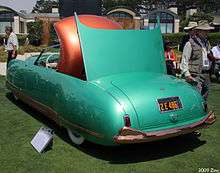
LeBaron was one of the many prominent coachbuilders in the 1920s and 1930s to provide bodies for luxury cars. It was founded in Bridgeport, Connecticut in 1920 by Thomas L. Hibbard and Raymond H. Dietrich. It was later purchased by the major manufacturer of bodies for Ford, Chrysler, Hudson, Packard and others Briggs Manufacturing Company of Detroit in 1926 and operated as a Briggs specialist subsidiary.
LeBaron supplied exquisite custom bodies for various car companies such as Chrysler's luxury Imperial line, Duesenberg, and Cadillac. LeBaron's last projects for Chrysler were the Chrysler Newport Phaeton, a super-streamlined dual cowl phaeton with an aluminum body and the remarkable 1941 Chrysler Thunderbolt, a sleek roadster with concealed headlights (like the 1936 Cord 810/812) and a retractable metal hardtop styled by Alex Tremulis, who would later style the legendary Tucker of 1948.[1][2][3][4]
Chrysler purchased Briggs Manufacturing in 1953.[4] Two years after the Chrysler Corporation introduced the Imperial as a separate luxury division, LeBaron was designated the top of the line Imperial models in 1957 through 1975.[1][2][3][4]
Classic generation (1931–1941)
| Classic generation | |
|---|---|
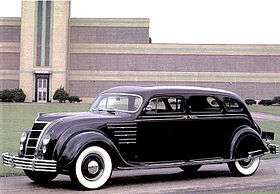 | |
| Overview | |
| Production | 1930s |
| Assembly |
Detroit, Michigan, United States Bridgeport, Connecticut, United States[1][2][3][4] |
| Body and chassis | |
| Class | Luxury |
| Body style |
2-door coupe 2-door convertible (roadster) 4-door sedan 4-door convertible |
| Layout | FR layout |
| Platform | Chrysler |
| Related |
Chrysler Chrysler Imperial |
| Powertrain | |
| Engine |
385 cu in (6.3L) Straight-8 125HP ("Imperial 8")[5] and others |
| Transmission |
3-speed manual 4-speed manual |
The LeBarons started in the 1930s during the automobile's Classic era and competed directly with the luxury brands of its day such as Lincoln, Cadillac, and Packard.
In the mid-1930s, Chrysler added a radical new "Art Deco" design shape, known as the Airflow Imperials, to the Chrysler line. The high-end CW series were supplied by LeBaron. The design features were considered advanced and perhaps ahead of their time. However, the shape was too radical for buyer's tastes and non-Airflow models outsold Airflows by about 3 to 1.
Raymond Dietrich, co-founder and former stylist at LeBaron, was hired in 1932 to be Chrysler's in-house stylist. Dietrich restyled the Airflow line and Chryslers moved to more mainstream styles. As a result of the poor Airflow sales, Chrysler design actually became quite conservative for the next two decades. Auto manufacturers continued to build up their in-house styling departments and bodyworks, with the result that LeBaron became less important to most of its customers for design ideas and bodies. Toward the late 1930s, LeBaron/Briggs built more bodies for Chrysler and fewer bodies for Ford. Chrysler became their biggest customer, with additional bodies built for Packard, Hudson, and Graham-Paige. During the late 1930s and early 1940s, the LeBaron name and division became less important for Briggs, although it remained a division of Briggs until the Chrysler buy-out in 1953.[3][4]
LeBaron's last projects for Chrysler were two concept cars: the Chrysler Newport Phaeton, a super-streamlined dual cowl phaeton with an aluminum body and the remarkable 1941 Chrysler Thunderbolt,[6] a sleek roadster with concealed headlights and a retractable metal hardtop styled by Alex Tremulis, who went on to later style part of the legendary Tucker of 1948. Only 6 of each were made.[1][3]
Imperial generation (1957–1975)
| Imperial generation | |
|---|---|
|
| |
| Overview | |
| Production | 1956–1975 |
| Assembly |
Jefferson Avenue Assembly Detroit, Michigan, United States |
| Body and chassis | |
| Class | Full-size luxury |
| Body style |
|
| Layout | FR layout |
| Platform | |
| Related | |
| Powertrain | |
| Engine |
|
| Transmission | 3-speed automatic |
The Chrysler Corporation introduced the Imperial as a separate luxury make and division in 1955. LeBaron was designated the top of the line Imperial models from 1956 through 1975.[1][2][3][4] These cars were Imperials and did not include the Chrysler nameplate. Vehicles branded "LeBaron" were the top model of the Imperial line, followed by the mid-line "Crown" and a short-lived nameless base model ("Custom" from 1960–63); with "Southampton" being a sub-designation applied to all pillarless hardtops.
The Imperial LeBarons were made to compete directly with competitor's luxury brands that included Continental, Cadillac, and Packard, as was the case during the 1930s.
The last Imperial model was assembled in June 1975, the discontinuation resulting from dwindling sales due to a recession, the effects of the 1970s energy crisis, and the United States Congress having passed the Energy Policy and Conservation Act, establishing Corporate Average Fuel Economy standards.
-
.jpg)
1960 Imperial LeBaron
-
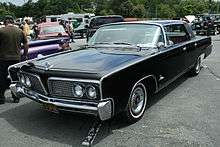
1964 Imperial LeBaron
-
1967 Imperial LeBaron
-
1972 Imperial LeBaron
-
.jpg)
1974 Imperial LeBaron
First generation (1977–1981)
| First generation | |
|---|---|
 | |
| Overview | |
| Production | 1976–1981 |
| Model years | 1977–1981 |
| Assembly |
St. Louis, Missouri (Saint Louis Assembly), United States Newark, Delaware (Newark Assembly), United States Valencia, Venezuela, Toluca, Mexico (Toluca Car Assembly)[7] |
| Body and chassis | |
| Class | Mid-size |
| Body style |
4-door wagon (1978-81) 4-door sedan (1977-81) 2-door coupe (1977-81) |
| Layout | FR layout |
| Platform | M-body |
| Related |
Chrysler Town and Country Dodge Diplomat Plymouth Gran Fury |
| Powertrain | |
| Engine |
225 in³ Slant-6 318 in³ LA V8 360 in³ LA V8 |
| Transmission |
3-speed A727 automatic 3-speed A904 automatic |

.jpg)
Although the LeBaron model name had been used before on Imperials, this was the first time the name was used as a Chrysler model. The cars used the Dodge Aspen platform, but with a different body shell known as the M-body, and their primary purpose was as a more upmarket version of the Aspen/Volare. Initial 1977 models comprised coupes and sedans, with a Town & Country station wagon appearing for 1978 (using the nameplate formerly carried by full-sized C-body Chrysler wagons). Engines consisted of the 225-cid Slant Six, the 318 V8, and the 360 V8. Most were equipped with the 3-speed Torqueflite automatic transmission, but a four-speed manual gearbox was offered with the two smaller engines until 1981.
In 1979, the LeBaron was reskinned for the 1980 model year to gain more crisp sheet metal, gaining a waterfall grille, new headlight fascias, and more angular taillamps. The rear roofline was also made shorter and steeper. The 2-door coupe received new smooth rear sheetmetal, that replaced the old curved rear panels. On the inside, enhancements were made to the interior to make it more luxurious. Also that year, a limited edition "Fifth Avenue" package was available; only 654 LeBarons were produced with this package. A police package was offered for that year as well.
The LeBaron model name was moved to the new front-wheel drive K-platform for the 1982 model year. The former M-body LeBaron sedan became the Chrysler New Yorker and could still be equipped with the Fifth Avenue package. The M-body wagons and coupes were discontinued after 1981. Chrysler's M-body sedan was ultimately renamed New Yorker Fifth Avenue for 1983 and then just Fifth Avenue starting in 1984. M-body Fifth Avenue production continued through 1989 little changed from the 1980-vintage LeBaron sedan.
See Town & Country and Fifth Avenue sections for more info.
Second generation (1982–1988)
| Second generation | |
|---|---|
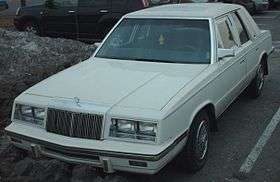 | |
| Overview | |
| Production | 1981–1988 |
| Model years | 1982–1988 |
| Assembly |
Newark, Delaware, United States (Newark Assembly) St. Louis, Missouri, United States (Saint Louis Assembly, Toluca, Mexico (Toluca Car Assembly) |
| Body and chassis | |
| Class | Compact |
| Body style |
4-door wagon (1982-88) 4-door sedan (1982-88) 2-door coupe (1982-86) 2-door convertible (1982-86) |
| Layout | Transverse front-engine, front-wheel drive |
| Platform | K-body |
| Related |
Chrysler Town & Country Dodge 400 Dodge Aries Plymouth Reliant |
| Powertrain | |
| Engine | |
| Transmission |
5-speed Getrag A525 manual 3-speed A413 automatic 3-speed A470 automatic |
| Dimensions | |
| Wheelbase | 100.3 in (2,548 mm) |
| Length | 179.2 in (4,552 mm) |
| Width | 68 in (1,727 mm) |
| Height | 52.9 in (1,344 mm) |
For 1982, the LeBaron moved to the front-wheel drive Chrysler K platform, where it was the upscale brand's lowest priced offering. It was initially available in just sedan and coupe versions.
In early 1982, it was released in a convertible version, bringing to the market the first factory-built open-topped domestic vehicle since the 1976 Cadillac Eldorado. A station wagon version called the Town and Country was added as well. A special Town and Country convertible was also made from 1983 to 1986 in limited quantities (1,105 total), which like the wagon featured simulated wood paneling that made it resemble the original 1940s Town and Country. This model was part of the well-equipped Mark Cross option package for the latter years.
Despite being mechanically similar to the Aries and Reliant, its fascias closely resembled those of the larger E-body sedans. This generation featured Chrysler's Electronic Voice Alert, a computerized voice which admonished drivers with phrases.
-

1987 Chrysler LeBaron sedan
-

1986 Chrysler LeBaron coupe
-
_fL%2C_Lime_Rock.jpg)
1986 Chrysler LeBaron Town & Country convertible
-
.jpg)
1985 Chrysler LeBaron Town & Country station wagon
The LeBaron was facelifted for 1986 receiving rounder front and rear ends to improve aerodynamics.
Coupes and convertibles were dropped for 1987, being replaced by the all-new J-body LeBaron released that year. The sedan and wagon continued with minor change until 1988.
A larger LeBaron sedan based on the Dodge Spirit and Plymouth Acclaim would arrive for the 1990 model year.
A 1983 Town and Country convertible was featured in the sixth and seventh seasons of the popular sitcom Seinfeld, that George Costanza purchased after being told by a car salesman that it was previously owned by actor Jon Voight, though it was later revealed that its previous owner was actually John Voight, a dentist that appeared in the episode "The Mom and Pop Store", where the car was first featured. In a later interview, the actor confessed that the car featured in the show wasn't actually owned by Voight himself, but by his mother, Barbara Voight.
1985–1989 LeBaron GTS
| LeBaron GTS/LeBaron | |
|---|---|
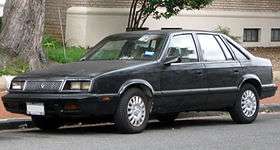 | |
| Overview | |
| Production | 1984–1989 |
| Model years | 1985–1989 |
| Assembly | Sterling Heights, Michigan, United States |
| Body and chassis | |
| Class | Mid-size |
| Body style | 5-door hatchback |
| Layout | Transverse front-engine, front-wheel drive |
| Platform | H-body |
| Related |
Dodge Lancer Shelby Lancer |
| Powertrain | |
| Engine |
2.2 L K I4 2.2 L Turbo I I4 2.2 L Turbo II I4 2.5 L K I4 |
| Transmission |
5-speed Getrag A520 manual 5-speed Getrag A555 manual 3-speed A413 automatic |
| Dimensions | |
| Wheelbase | 103.1 in (2,619 mm) |
| Length | 180.4 in (4,582 mm) |
| Width | 68.3 in (1,735 mm) |
| Height | 53 in (1,346 mm) |
The 1985 LeBaron GTS was a somewhat different car than the standard LeBaron and was based on the Chrysler H platform. It was available at the same time as the Cadillac Cimarron as a luxury-brand model, while offering a similar level of equipment to the small Cadillac. As a 5-door hatchback still derived from the K-car, the GTS (and the similar Dodge Lancer) was more of a performance vehicle, than the softer-tuned K-car LeBaron sedan. In base configuration, the car was powered by Chrysler's 2.2 liter inline-4 engine, later replaced by a 2.5 L TBI version generating 100 hp (75 kW). A turbocharged 2.2 L engine producing 146 hp (109 kW), was also available. The GTS moniker was dropped for 1989, the final year of this vehicle's production, after the K-based LeBaron sedan was discontinued. The last Chrysler LeBaron GTS rolled off the assembly line on April 7, 1989.
Trim levels
- Highline - 1985–1989
- Premium - 1985–1988
- GTS - 1989 (replaced "Premium" after the "GTS" was dropped from the name of the car)
- "Pacifica" 1986 (replaced by Shelby Lancer in 1987) Limited 500 run
European market - the Chrysler GTS
After some years of absence, Chrysler officially started offering some models under its own brand on the European market from April 1988 on. One of them was the "Chrysler GTS", which in fact was a rebadged version of the Dodge Lancer ES. Sales figures were moderate.
Third generation coupe/convertible (1987–1995)
| Third generation (coupe/convertible) | |
|---|---|
 | |
| Overview | |
| Also called | Chrysler Phantom (Mexico) |
| Production | 1986–1995 |
| Model years | 1987–1995 |
| Assembly |
Newark, Delaware, United States (Newark Assembly) St. Louis, Missouri, United States(Saint Louis Assembly) Toluca, Mexico (Toluca Car Assembly) |
| Body and chassis | |
| Class | Personal luxury |
| Body style |
2-door coupe (1987-93) 2-door convertible (1987-95) |
| Layout | Transverse front-engine, front-wheel drive |
| Platform | J-body |
| Related | Chrysler TC by Maserati |
| Powertrain | |
| Engine |
2.2 L Turbo I I4 2.2 L Turbo II I4 2.2 L Turbo III (only for Mexican market) I4 2.5 L K I4 2.5 L Turbo I4 3.0 L Mitsubishi 6G72 V6 |
| Transmission |
2.2 and 2.5 L engines 5-speed Getrag A520 manual 5-speed Getrag A523 manual 3-speed A413 automatic 3.0 L V6 engine 5-speed Getrag A543 manual 5-speed Getrag A555 manual 5-speed Getrag ass. A568 manual 3-speed A670 automatic 4-speed A604 automatic |
| Dimensions | |
| Wheelbase |
100.5 in (2,553 mm) (1992–95 coupe) 100.6 in (2,555 mm) (1992–95 convertible) 100.3 in (2,548 mm) (1987–1991 coupe) 100.4 in (2,550 mm) (1987–1991 convertible) |
| Length | 184.8 in (4,694 mm) |
| Width |
69.2 in (1,758 mm) (1992–95) 68.5 in (1,740 mm) (1987–1991) |
| Height |
51.2 in (1,300 mm) (1992–95) 50.9 in (1,293 mm) (1987–1991) |
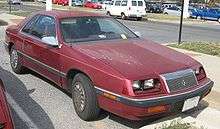
After discontinuing the first generation LeBaron coupe and convertible in 1986, Chrysler released a new LeBaron for 1987, built on the J platform (a K platform derivative) and available as a coupe or convertible. The all-new LeBaron looked modern and aerodynamic compared to its boxy predecessor. It featured headlights hidden behind retractable metal covers, a waterfall grille, steeply raked windshield, full-width taillight lenses (though only the edges actually lit up), and curved (Coke bottle) style rocker panels. In Mexico, these models were marketed as the Chrysler Phantom.
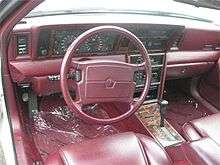
Available engines were the stock 2.2 liter and 2.5 liter, naturally aspirated or turbocharged, and for the 1990 model year a 3.0 liter Mitsubishi V6 became available, although the Mexican Chrysler Phantom R/T DOHC 16V also offered the same 2.2 liter turbo engine as used in the US market Dodge Spirit R/T.
The LeBaron was available with a trip & fuel economy computer and full instrumentation. For 1990, the LeBaron's interior was refreshed, featuring an all new dashboard, gauge cluster, door panels, and center console design. All of the new components were designed to be smoother and more flowing than the comparatively blocky 1987-89 interior style, making it more in tune with the "aero" revolution of the early 1990s.

1992 LeBaron coupes and convertibles could be ordered with a new "sport package", which featured a monochrome appearance including body-colored grille, accent stripe, and decklid logo. The package also included 14-inch "lace" style wheelcovers and a black strip below the taillights in place of chrome, with special blacked-out window moldings on coupe models.[8]
Racing
Several ARCA (one tier down from NASCAR cup racing) teams built LeBaron based race cars (supported by a revitalized Chrysler Direct Connection performance parts division) and ran them from 1988 to 1998. The cars were very competitive and won several races during those years.
1993 restyle
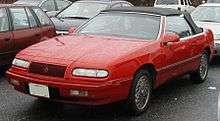
In 1992, the 1993 LeBaron received a slight restyling. The hidden headlamps of the 1987-1992 models were deleted in favor of less costly aerodynamic replaceable-bulb headlamps, new wheel styles were made available, and all models got the amber rear turn signals introduced on the deluxe 1992 models. New for 1994, was the "Bright LX" decor package and a passenger side airbag. It included a "bright" chrome grille, "bright" chrome badging, and "bright" chrome molding inserts, as opposed to being body-colored on the GTC. Available engines were naturally aspirated 2.5 L and turbocharged 2.2 and 2.5 L versions of Chrysler's I4, and the 3.0 L Mitsubishi V6 making a 141 hp (105 kW) in this application. The coupe was discontinued after 1993. In 1994 the 3.0 was the only available engine. The convertible was discontinued after 1995, to make way for the new Chrysler Sebring coupes and convertibles, for 1995 and 1996 respectively.
Trim levels: 1987–1995
Throughout its lifetime, the LeBaron convertible/coupe was available in many trim levels. For its first year, the LeBaron was available in Highline and Premium, typical Chrysler trims at the time. The number of trims grew, peaking in 1990, with six available. After that, the number decreased until just two trim levels remained for 1995.
|
|
Third generation sedan (1990–1994)
| Third generation (sedan) | |
|---|---|
 | |
| Overview | |
| Also called | Chrysler New Yorker (Mexico) |
| Production | 1989–1994 |
| Model years | 1990–1994 |
| Assembly |
Newark, Delaware, United States(Newark Assembly) Toluca, Mexico (Toluca Car Assembly) Valencia, Venezuela |
| Body and chassis | |
| Class | Mid-size |
| Body style | 4-door sedan |
| Layout | Transverse front-engine, front-wheel drive |
| Platform | AA-body |
| Related |
Dodge Spirit Plymouth Acclaim Chrysler Saratoga (Export only) |
| Powertrain | |
| Engine |
2.5 L Chrysler I4 3.0 L Mitsubishi 6G72 V6 |
| Transmission |
2.5 l engines 5-speed Getrag A523 manual 3-speed A413 automatic 3 Litres engines 5-speed Getrag A543 manual 5-speed Getrag A555 manual 5-speed Getrag ass. A568 manual 3-speed A670 automatic 4-speed A604 automatic |
| Dimensions | |
| Wheelbase | 103.5 in (2,629 mm) |
| Length | 182.7 in (4,641 mm) |
| Width | 68.1 in (1,730 mm) |
| Height | 53.7 in (1,364 mm) |
| Curb weight | 2,971 lb (1,348 kg) |
| Chronology | |
| Successor | Chrysler Cirrus |
The last LeBaron sedan was built on the front wheel drive AA platform, another K derivative, as junior level sedan to the more upscale New Yorker. It differed from the Dodge Spirit and Plymouth Acclaim, as well as the European Chrysler Saratoga mostly in detail and trim choices. Theoretically, as historically was the case in this era whenever Chrysler, Dodge, and Plymouth shared direct model variants, the Acclaim was supposed to be the more mainstream version, while the Spirit was the sportier version, and the LeBaron was the luxury version, reflecting the Chrysler brand's flagship status. In reality, however, there was considerable overlap amongst the three in available trim, equipment and features. The top-line LeBaron Landau model offered a padded vinyl half-roof with smaller "formal" backlight.
All LeBaron sedans came with a standard driver's side airbag, could seat up to six passengers, and had a relatively large trunk.
For 1992, the LeBaron sedan was split into three trim levels: base, LX and Landau. The new entry model eliminated the previously standard V6 engine and landau vinyl roof while the Landau model still included the landau roof as standard. The LX, available one year only, offered standard V6 but no landau roof. For 1993, the LeBaron sedan received new rear lights, which incorporated the reversing lamps previously located in the bumper fascia. Also that year, the lineup was reduced to two trim levels with the entry model now labeled LE.
The LeBaron sedan was discontinued on May 18, 1994 while the Dodge Spirit and Plymouth Acclaim continued production until December 9, 1994. The Chrysler LeBaron was replaced by the "Cloud Car" Chrysler Cirrus.
Safety
In 1994, the U.S. National Highway Traffic Safety Administration rated the LeBaron a 4 out of 5 for driver side and a 3 out of 5 for passenger side frontal impact occupant protection.
Trim levels
- base - 1990–1992
- LX - 1992
- Landau - 1992–1994
- LE - 1993–1994
Mexican market
M and K-platform cars were assembled in the Toluca, Mexico facility. The M-platform LeBaron was sold in Mexico from the 1977 to the 1982 model years. The K-car LeBaron was also produced in Toluca and was sold for the 1983-87 model years. There were no K-platform convertibles, at least none right from the factory.
Chrysler Phantom was the Mexican-market version of the J-Body LeBaron Coupe. There were no convertibles of the J-body 2-door for the Mexican market. Phantoms were sold with the same options as the LeBarons in the U.S., and frequently at a higher trim level. Chrysler Phantoms were marketed from 1987 to 1994, with an R/T version (similar to the American LeBaron GTC) starting in 1992.
The Mexican A-A-body Chrysler Lebaron 4-door sedan was called the New Yorker (all of them with Landau roof), and the "K" body (slightly shorter) was reserved for the 4-door LeBaron's, which were sold in two trim levels, one with Landau roof and leather, and the other one without those two options.
References
- 1 2 3 4 5 "Chrysler LeBaron History". Webspace.webring.com. Archived from the original on 2010-12-06. Retrieved 2010-10-04.
- 1 2 3 4 "1985 Chrysler LeBaron Images, Information and History (LeBaron Town & Country, LeBaron Mark Cross Convertible, T&C, LeBaron GTS, LS Sedan)". Conceptcarz.com. Archived from the original on 2010-12-06. Retrieved 2010-10-04.
- 1 2 3 4 5 6 "Coachbult.com - LeBaron - Le Baron - LeBaron Carrossiers - LeBaron Inc. - LeBaron-Detroit". Coachbuilt.com. Archived from the original on 2010-12-06. Retrieved 2010-10-04.
- 1 2 3 4 5 6 "Briggs Body Company, Brggs Mfg, Co., Walter O. Briggs, LeBaron, Briggs Detroit, John Tjaarda, Coachbult.com". Coachbuilt.com. Archived from the original on 2010-12-06. Retrieved 2010-10-04.
- ↑ "1931 Chrysler Imperial Close Coupled Sedan". Imperialclub.com. 1930-07-14. Archived from the original on 2010-12-06. Retrieved 2010-10-04.
- ↑ "Special Built Cars Hint Tomorrow's Designs" Popular Mechanics, January 1941
- ↑ "1978 Chrysler LeBaron (VE)". Dkarros.com. Archived from the original on 2010-12-06. Retrieved 2010-10-04.
- ↑ 1992 Chrysler LeBaron Factory Sales Brouchure
Sources
- Coachbuilt: LeBaron Carrossiers - 1920-1925, LeBaron Inc. - 1925-1928, LeBaron-Detroit - 1928-1942
- Coachbuilt: Briggs Manufacturing Co. - 1909-1954
- Conceptcarz: Chrysler LeBaron news
- Allpar: LeBaron Coupe
- Consumer Guide: 1990-1995 LeBaron coupe/convertible reviews
- Consumer Guide: 1990-1994 LeBaron Sedan reviews
- Front-Runners.net - LeBaron Road Test (PDF)
External links
| Wikimedia Commons has media related to Chrysler LeBaron. |
- Chrysler LeBaron History
- Chrysler Le Baron GTC
- MyLebaron
- LeBaron.de - German Forum, Gallery, KnowHow...
- Chrysler K-car Club